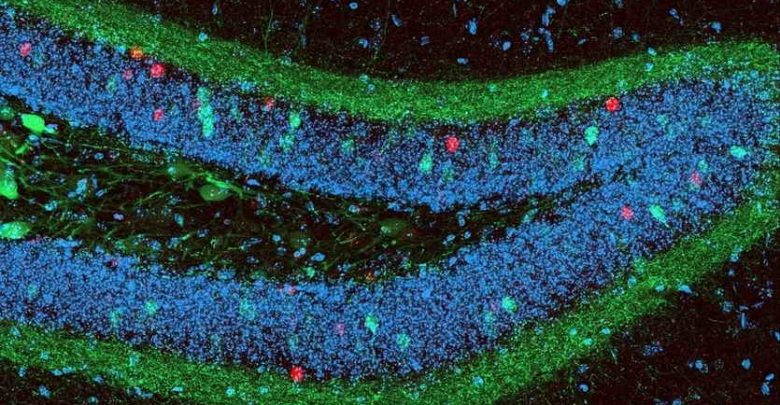How to dial up or down emotional memories

Memories of traumatic experiences can resurface over and over again, causing great emotional distress. This is a hallmark symptom of psychiatric diseases such as PTSD, anxiety, and depression. Dr. Steve Ramirez, a neuroscientist at Boston University, believes that a small structure in the brain, called the hippocampus, could be a key node for therapeutic techniques aimed at getting patients to regulate their emotional memories.
In a recent paper published in Current Biology, Ramirez and his research team showed how, in a mouse, traumatic memories can be linked with emotion and how behavioral responses to recalling these memories can be turned up or down depending on what part of the hippocampus is manipulated.
Researchers identified neurons in a mouse hippocampus involved in fear learning or encoding (shown in green). Another group of cells (red) were involved in recalling a fear memory.
Photo credit: The Ramirez Group/ Boston University
By using optogenetics, a technique that allows researchers to stimulate or suppress the activity of cells containing special genetically encoded proteins that respond to laser light, Ramirez and Chen, a graduate student researcher and lead author on the paper, mapped out which cells in the hippocampus respond when male mice formed new memories of a positive, neutral, and negative experience. A positive experience, for example, happened when the male mouse was exposed to a female mouse, whereas a negative experience occurred was defined as a mild shock to the feet. Later, researchers were able to use laser light to trigger the memory cells originally encoding these experiences.
Location of the laser stimulation mattered; activating the top part of the hippocampus during memory recall relieved negative emotional or behavioral responses, whereas activating the bottom part enhanced fear and anxiety-related behaviors. This anatomical distinction is critical, says Ramirez. It suggests that suppressing overactivity in the bottom part of the hippocampus could possibly be used to treat PTSD and anxiety because this part of the brain may be hyperactive in the diseased state.
So, what does this mean for treating people?
“We’re never going to be going around sticking fiber optics inside the brain of human patients,” says Dr. Ramirez. This is not only ethically questionable, but impractical to have patients walking around hooked up to lasers. By studying this neural dial in the brains of mice, Ramirez hopes they can figure out what makes these cells unique, such as identifying a special type of receptor that exclusively exists in these memory cells.
“Then we can start thinking of making compounds that attach only to that circuit, instead of flooding the whole brain like all the drugs we have today, all of which cause side effects,” he says.
Next, Ramirez and his team are investigating what happens when you turn up a positive memory, rather than a negative one. Could you, for instance, turn a negative memory into a positive or neutral memory by boosting the feel-good centers of the brain during traumatic memory recall? This has huge therapeutic potential for treating those with PTSD, who suffer from constant, uncontrollable recalll of negative emotional memories.
Source: WIRED, ScienceDaily
(https://www.labroots.com/trending/neuroscience/14689/how-to-supress-enhance-emotional-memories)
 Каз
Каз Рус
Рус Eng
Eng
